Ap Studio Art Artist Statments Ap Studio Art Artist Statements
Last Updated on February 24, 2022
These are a selection of works and commentaries from Ratthamnoon Prakitpong, a graduate from Thai Chinese International School in Bangkok, Thailand. Ratthamnoon was i of sixteen students worldwide to receive a score of 100% for his AP Studio Fine art Drawing Portfolio in 2015, earning every bespeak possible on each portion of his portfolio. His portfolio scored a perfect six.


AP Studio Art: Breadth
The Breadth department of the AP Studio Art portfolio is a great gamble to brush up on skills and experiment. The Latitude department of the portfolio consists of 12 works of art that demonstrate a mastery of skills whilst showing the artistic range of a student. Here are some examples of what I did to make my piece of work amend and more personal:
The importance of a good limerick

For this course project, we had to work on transparent textures. Having potent painting skills is of import; having a strong composition to work from equally then. The starting time batch of preliminary images I did were indoors with two wine glasses. I felt like the dissimilarity and depth were sufficient, but my instructor, Elizabeth Jendek, asked me to try other kinds of glass to make the composition more than interesting. I took loads of photos to discover compositions that worked. On the 2nd and third preliminary compositions I presented to my teacher, the light was indoors and the glass didn't accept reflective areas. The third composition was better because of the outdoor lite, just it nonetheless wasn't great.
And so my teacher suggested I photograph outside in dusk. Existence outside made the still life look more natural and lively; these effects were emphasized by the striped cloth, which increased movement. In addition, the sunset's orangish calorie-free really heightened the spectacles' polish and contrast. With the tabular array's directional line, I got the depth back from the first composition that was lost during the second and tertiary tries. My composition was strong because my focal bespeak was to the side, which follows the rule of thirds: there were size relationships showing depth and perspective. There also was variation by color and shape, making the composition more than stimulating. A potent composition illuminated my skill of painting. Although this is a drawing portfolio, a good composition is every bit of import equally your great skill of painting in and of itself. To go the best compositions, I questioned myself; I didn't wait things to work out the very commencement time, listened to my peers and teacher's advice, and kept working on it until I got the best composition.
Revisiting piece of work makes a big difference
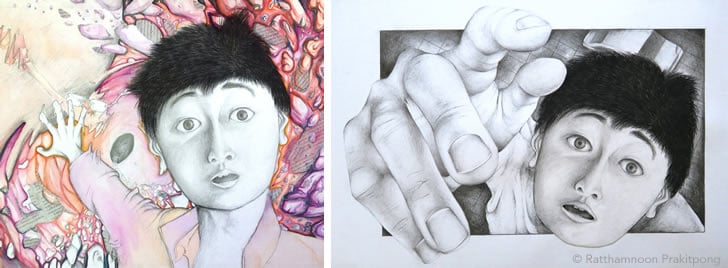
As my skills improved, I found that some of my work looked a little uneven. I had a portrait that I did before, which no longer matched the skill level of my other work. Since the face was working fine, the instructor and I discussed the thought of cutting and pasting the head onto a new image. I took a few photos and did a new composition in Photoshop and came up with a new image. Once I was confident with my new idea, I sketched out my new composition on fresh paper, cut out the confront and glued it to the new composition. My new version was much better and it evened up my skill level throughout the portfolio in my terminal submission.
I took calculated risks with time and limerick. I scheduled my time well and used all the good guidance and technology bachelor to finish this drawing. Information technology turned out to be i of my favorites.
Sometimes abandoning a piece of work of fine art is ameliorate than to keep fighting it
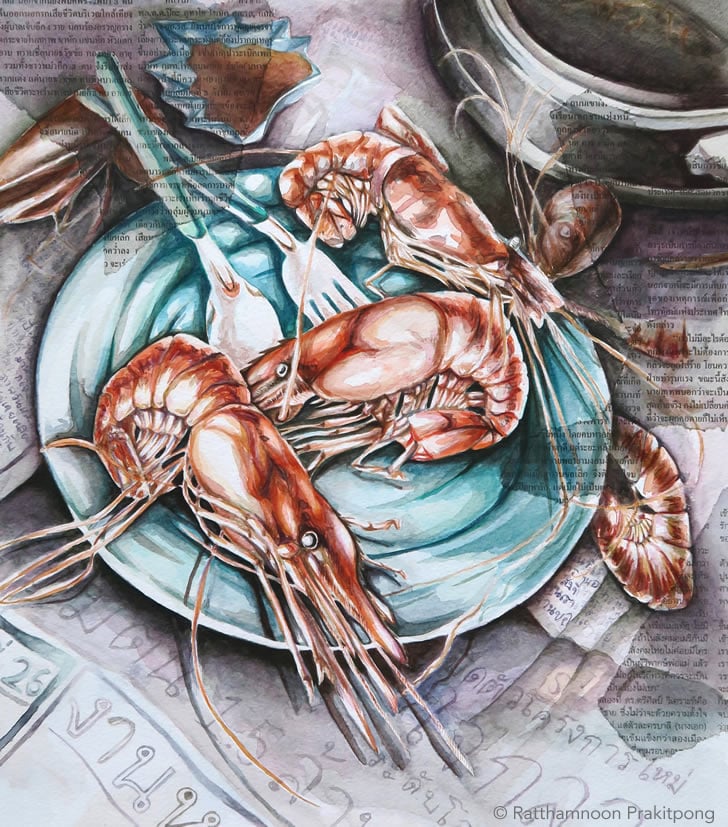
While I was doing my portfolio, I had a few compositions that needed reworking – one in particular really only wasn't working out. I tried adding more than to the composition; I did loads of preliminary sketches, and finally decided I was getting nowhere. Afterward discussing and problem-solving with my teacher, we decided it would be better to get-go a fresh new artwork based off an alternative lesson. Information technology'south true that information technology was hard to let become of so much work already done, and the new projection was as challenging, but it worked much better than if I would've continued beating a dead horse.
To compensate for lost efforts, I tried to add my own personal touches to this art piece. Fifty-fifty though the dark-green plate can be seen just as a nice contrast to the orange shrimp, information technology'south also the same plate my family unit uses when nosotros go out picnicking. We unremarkably lay old newspapers underneath our seafood so that mess won't spill anywhere. I took direct inspiration from that, and glued newspaper onto my work for texture; to finish, I copied Thai messages onto the composition. By adding my own personal touch, this simple projection became more unique, and much richer. They were my shrimp, and this is how I eat them.
Wait for inspiration around you, in unlikely places

Friends and I went on a hiking trip to Phu Kradueng. In this area of Thailand, automated services aren't bachelor, then local couriers offer their services past carrying huge loads to the top of the mountain surface area. Watching these men lift such enormous amounts was inspirational, and I took this groovy photo capturing their forcefulness and beauty – it reminded me of Greek Gods. Although this wasn't a class project, I painted information technology on my own anyway for ii reasons: the tourist sight was so unique, and information technology was also an important retentivity for my friends and I. To further the personal nature of this image, I glued my train ticket to the composition to further add to that feeling of a snap in time, fully enclosing the character of the place and to add together additional texture.
AP Studio Art: Concentration
Concentration is a department where I focused on a specific topic and many art skills. It'due south very intense and pressuring. Here I commented on a few skills that I focused on to make my Concentration more than successful:
Picking the correct Concentration topic is incredibly of import
Since the Concentration section needed twelve pieces based on a unmarried topic, my teacher advised the class to look long and hard for a topic that had room for evolution and exploration, yet remained accessible. It took me a few months, simply I settled on a Concentration topic virtually different perspective-based portraits in the kitchen.
Thematically, I picked this topic because I was already a hobbyist cook, and wanted to combine and explore the two things that I liked – art and cooking. I experience, in my land, there'southward a cultural stigma virtually men in the kitchen that I wanted to both question and eradicate by demonstrating that men tin melt as well equally anyone else.
I decided to pursue portraits and create variation using dissimilar perspectives and color schemes. For my take on perspective, I used a selfie stick to find new perspective and angles. Where my hands were belongings the camera, I superimposed kitchen tools – spoons, forks, spatulas – to hide the selfie stick in the drawing. Equally for the kitchen itself, I found inspiration from my personal exploration in using new kitchen tools, like cooking noodles for my tiffin box or eggs in the forenoon. These were additional considerations I fabricated when selecting this topic:
- My exploration was non only visual, but personal too. It showed my development as an creative person and a thinker. I only had around 5 ideas at the beginning because I wasn't familiar with the kitchen, but as I personally explored the kitchen more, inspiration came naturally.
- I cared about my topic. I was exploring my hobby and my culture. If I wasn't passionate about my topic, by the 8th or 9th epitome I would've hated my piece of work. Artwork without passion is apparent.
- It was visually appealing. Even though my personal story and passion were there, my Concentration wouldn't be equally strong if I did not play with perspectives and color schemes. I was really experimental well-nigh it too, and when the compositions didn't work, they still served as a springboard for the side by side idea.
- My topic was versatile enough to accept twelve different ideas united nether it. The kitchen has interesting tools, objects and angles I could employ to experiment. That kept my idea fresh, even so united.
- My topic was flexible. Choosing my kitchen as a basis for my topic might seem elementary, but it provided enough room for experimenting with techniques that weren't necessarily kitchen-related, similar superimposition or collage.
- My topic was accessible. I could go dorsum easily to the kitchen and photograph some more, or look for other inspirations. This made a huge difference when some compositions needed more reworking than others.
(If you are struggling to come upwards with your own AP Studio Art Concentration ideas, please read: Art Project Ideas: a guide to subject matter selection).
Here are some examples of how I problem-solved composition concerns, increased depth, and manipulated my imagery.
I experimented with depth

I increased depth with my selfie stick; information technology gave me more than options with regards to angles. The first limerick in which I used the stick didn't quite capture what I wanted, so I added an additional shelf at the top of my composition to increase depth. I used a fisheye lens to brand the composition more than interesting, and changed the hands that held the selfie stick altogether. I as well manipulated color from the originally bland white into a triad color scheme to make it more visually dynamic.
Combining multiple skills enriches your art
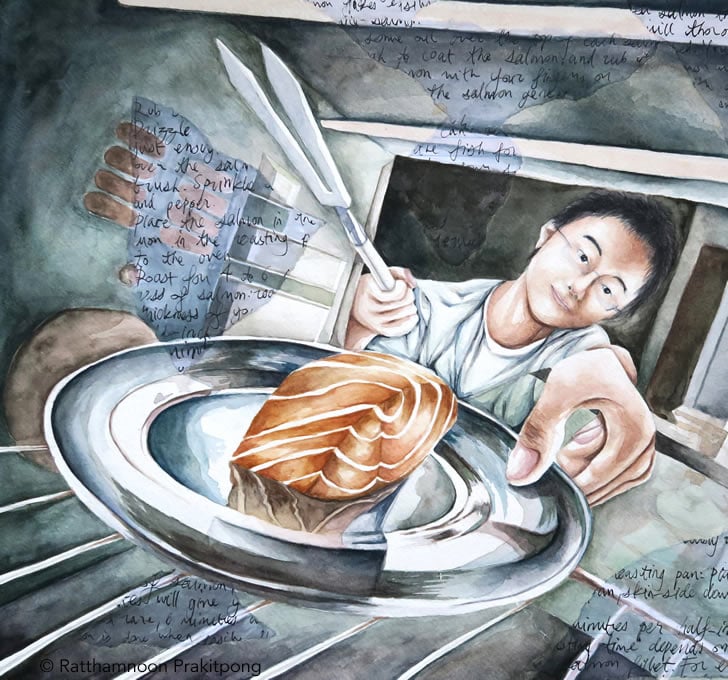
I had already used bird'due south eye and worm'due south eye of view, so I had to come up up with something unique for this ane. When I looked at the oven, I remembered when my female parent baked and thought of her delighted face up when she pulled out her baking. Then I decided to render some freshly baked food and the repose on someone's face when they beginning run into the food. This gave my image more personal meaning. I likewise added pieces of a hand written recipe for texture and to increase movement. Additionally, I superimposed a meat fork where my selfie stick had been.
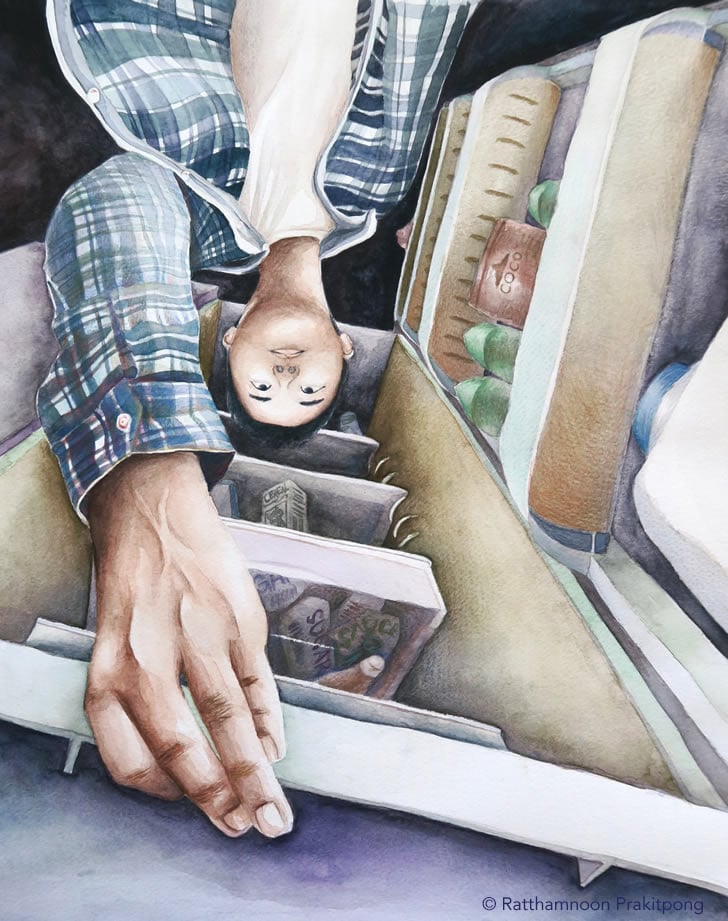
Final thoughts
In retrospect, I made many gutsy moves, and I failed – a lot. However, I succeeded a lot as well. It really came down to delivery, to do, to having many chances to fail and, in plow, to succeed. I made more than 24 art pieces, but I got to cull the ones I was really proud of for a trimmed version of my portfolio. Virtually importantly, I'chiliad merely some other person, and what I did may not utilize to yous. Mind to the people who know you, who are shut to yous – your teacher, your peers, and yourself. There's no point in making annihilation unless you will be proud of it. That means sometimes an unyielding stance, or sometimes blind organized religion in communication.

This AP Studio Fine art Drawing course was taught by Elizabeth Jendek. Work from her students is used past Alison Youkilis, an AP Fine art instructor trainer, to teach other educators around the globe. You can encounter additional outstanding artworks by Elizabeth Jendek's students in the article: 50+ All the same life drawing ideas for art students.
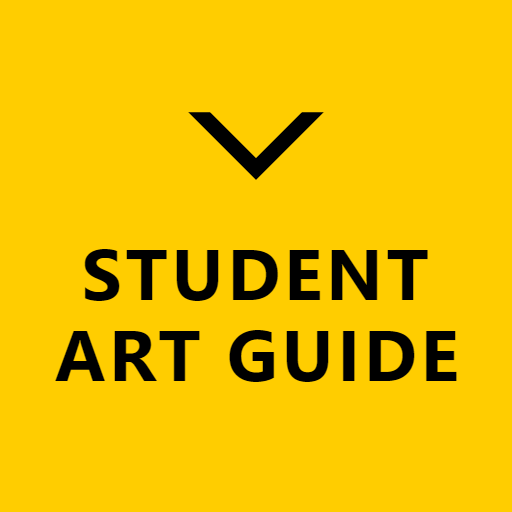
This high school fine art project was shared with our audience so that other students may benefit from the ideas, techniques and approaches used. Nosotros celebrate the effort and achievement of high school students and Art Departments around the world. If you would like to share your own art project (or that of your students), please read our submission guidelines.
Post a Comment for "Ap Studio Art Artist Statments Ap Studio Art Artist Statements"